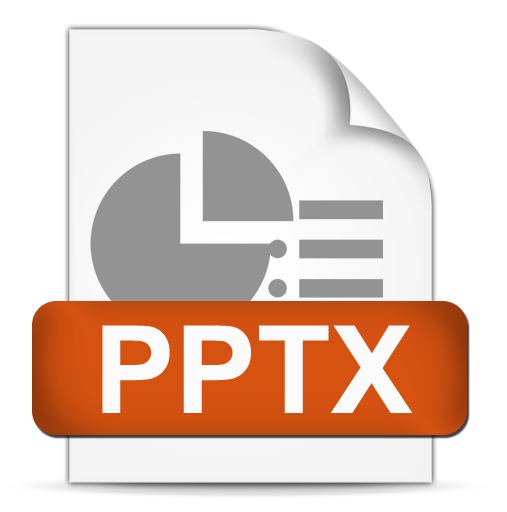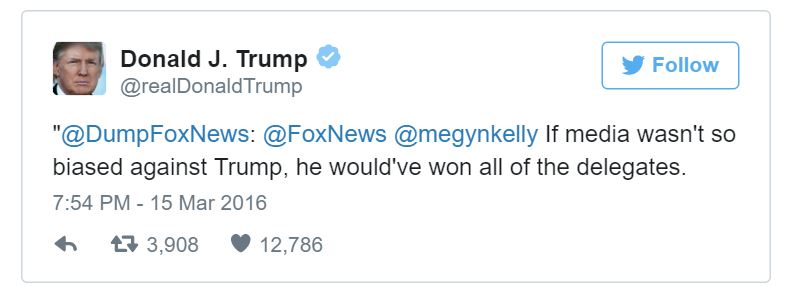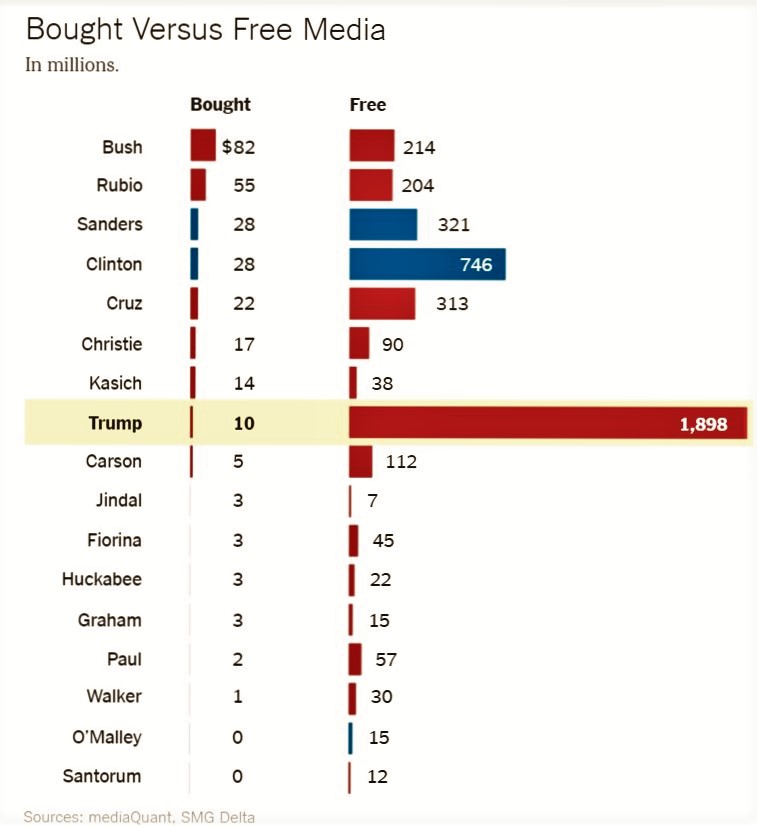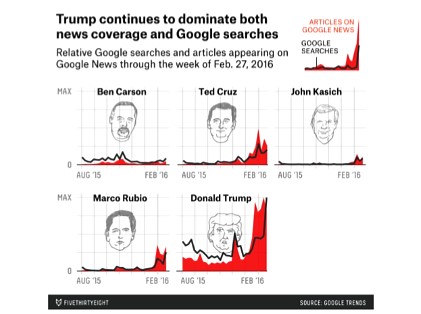Lesson Outline
 Download this lesson as a PowerPoint Presentation
Download this lesson as a PowerPoint Presentation
SERIES: Making sense of the campaign / Lessons in News Literacy. Drawing upon the 2016 presidential campaign for examples, this series of teacher's guides provides everything instructors will need to tailor foundational News Literacy lessons to their students and classroom. You'll find a detailed briefing identifying and applying specific News Literacy concepts, clear objectives and takeaways, multimedia, discussion questions and assignments that can be used in the classroom or as homework. We're also providing a PowerPoint presentation for classroom use that you can use or modify. As the campaign unfolds, we will supplement this guide with timely examples.
TOPIC: What's news and who decides? Why some stories rise to the top of the news ─ and, in the 2016 presidential campaign, why one candidate has dominated the news so far.
CONCEPTS: Universal "news drivers," editorial judgment, the growing power of the audience to shape news coverage and the influence of profits and competition,
OBJECTIVE: To provide an understanding of how the concepts combine to decide which stories get covered and which rise to the top of the news.
What makes news? Donald Trump
Virtually from the beginning of the 2016 presidential campaign, Donald Trump has dominated news coverage.
Armed initially with a Twitter account, his jet and helicopters, Trump has held the attention of reporters, editors and producers with his celebrity status as a reality TV star, his identity as an unconventional outsider and his ability to draw and captivate large crowds. By any measure, he leads the other candidates in news exposure on screen and in print by several fold. In the month of February, before the first Super Tuesday vote, Trump captured half all news articles and more than three times the number afforded to Democratic front-runner Hillary Clinton. Among the GOP candidates, both Ted Cruz and Marco Rubio tied for second each with a slim 9 percent of print coverage.

Just why has Trump so dominated media coverage?
“We would not be doing our jobs if we were not giving him an inordinate amount of attention,” National Journal columnist Ron Fournier told the Columbia Journalism Review. “He is the front-runner.”
Clearly, the news media wouldn't be paying so much attention to Trump if no one was voting for him. But the other candidates in the race don't see the disproportionate nature of news coverage devoted to the Trump campaign as being justified.
“You guys can’t stop covering him …” Clinton told MSNBC town hall host Chris Matthews during a commercial break. “It’s just like candy by the bushel.”
During an interview with CNN's Chris Cuomo, Bernie Sanders, said “a recent study showed that on ABC evening news Trump got 81 minutes of time. Bernie Sanders got 20 seconds. Now you tell me why.”
And Cruz, Trump's chief rival for the GOP nomination, has gone so far as to suggest that a vast media conspiracy is at work. “The Democrats are — I mean, look, to be honest, an awful lot of the mainstream media is using kid gloves on Donald right now because they want Donald to be the nominee,” Cruz told Megyn Kelly on Fox News. “And the instant he’s the nominee, they will unleash every cannon they can to elect Hillary Clinton.”
Trump, meanwhile, seems to complain about the news media at every opportunity, taking issue not with the amount of coverage but his perception that it's been too negative.

As a savvy business person, Trump is clearly aware of the leverage that comes with being in such demand. “I go on one of these shows and the ratings double, they triple,” Trump told Time magazine. “And that gives you power.” One example: Sunday morning news shows like "Face the Nation" have waived their usual insistence on face-to-face interviews and allowed Trump to phone in.
With all the free media exposure Trump has gotten, he hasn't had to spend the millions of dollars that his rivals have on campaign ads. This chart was put together by The New York Times using data from MediaQuant, which tracks and compares each candidate's paid political advertising and free media coverage, using advertising rates. to compute dollar values.

There are three culminating questions for students coming out of this lesson.
- How can we explain the disproportionate amount of coverage the Trump candidacy has received?
- Is it justified?
- Why, or why not?
In a campaign that has turned conventional wisdom on its head in so many respects, the explanation may be found in looking at some time-tested News Literacy concepts.
UNIVERSAL NEWS DRIVERS
News Literacy teaches us that several factors determine how much coverage a news story will receive. A starting point, though, is looking at 10 Universal News Drivers. These characteristics have been common attributes of news stories through recorded history in every society. The theory is that the more news drivers a story has going for it, the more prominence it will receive. Below, you'll find the 10 drivers, organized by the key questions every news story must answer. And you'll see just about every one has been helping drive coverage of the Trump campaign.
WHO?
1. Prominence (it’s news because of who is involved)
This is the news driver that elevates stories about celebrities, and Trump's stature as a billionaire real estate developer and reality TV star certainly makes him one.
WHAT?
2. Importance (news and topics with great implications)
The presidential race is obviously of huge significance to the country’s leadership and policies, but primary turnouts and exit polls indicate it has taken on heightened importance for a segment of the electorate that is “angry,” to use a word Trump has embraced. Fears rising from demographic and social changes, the unevenness of the economic recovery, the impact on workers of the shifting global economy and dissatisfaction with the GOP establishment have all been cited as factors in Trump's rise.
3. Human interest (people stories, may be more poignant than important)
Trump's wealth and his lifestyle, complete with jets, fancy apartments and beach homes, have obvious appeal. The story of his improbable rise has also captured the imagination of many.
4. Conflict (clashes of people, institutions or ideas)
Trump has insulted debate opponents and challenged figures revered within the GOP establishment. He has feuded with popular Fox News anchor Megyn Kelly, disparaged Sen. John McCain's status as a war hero, blamed President George W. Bush for the World Trade Center attack and verbally sparred with the pope over illegal immigration. He has also promoted controversial policies targeting Mexicans and Muslims. As a result, some of Trump's campaign events have been marred by protests and fistfights.
5. Change (progress, regress)
Trump is an agent for change, not only in terms of what he proposes to do if elected but because he is a different kind of political candidate ─ one who has never held public office. In addition, the story of what's happened to the Republican Party and this twist in the traditional path to the presidency has become a compelling part of the Trump narrative.
6. Unusualness (man bites dog)
This campaign, featuring the unlikely rise of a brash outsider who flouts political wisdom and convention, is “the very definition of man bites dog, the old reporter cliché about what constitutes news,” MSNBC host Chris Hayes said on Facebook.
WHERE?
7. Proximity (how close to home — the local news driver)
The ascendancy of Donald Trump can't be considered a local story, except perhaps in New York, and perhaps Florida, where he scored a key primary victory,
WHEN?
8. Timeliness (news context makes the story’s timing especially good)
The campaign calendar, with its debates, primaries and caucuses, keeps Trump's name in the news. Win or lose, Trump is a major part of the story, though his success has clearly made this news driver more of a factor.
HOW MANY?
9. Magnitude (how many — stories driven by numbers or quantity.)
Probably not one of the stronger news drivers at play, but the race for the GOP nomination has focused a lot of attention on numbers ─ both the large number of candidates who began the race, the large numbers turning out for Trump rallies, the obsessive focus on poll numbers and the running delegate count.
WHO CARES?
10. Relevance (How wide is the story’s impact and audience?)
However you feel about the candidate, this story hits home for Americans and has drawn global attention as well.
INTERESTING VS. IMPORTANT
Two other factors go into determining which stories get covered and which get the best play ─ the judgment of editors and the preferences of their audience.
Editors have long faced the challenge of balancing their public service mission of giving consumers the important news they need with the economic imperative of keeping people watching and reading. Put simply, it's the battle between what's important and what's merely interesting.
In the early days of the campaign, that battle between these competing interests played out in different ways in different newsrooms. Let's look at the phenomenon from the vantage point of three very different Posts.
The Huffington Post decided it was going to cover the Trump campaign purely as entertainment ─ a stance it had to abandon when he began winning primaries.
For the tabloid press, every controversial remark, even endorsements, pushed other news off the front page. How could the New York Post resist a news conference pairing Sarah Palin and Donald Trump?

Another, more serious newspaper, The Washington Post, has approached his candidacy by fact-checking his statements and keeping track of his campaign promises. This video looks at 50 promises in less than two minutes.
It's not that the Trump candidacy hasn't been scrutinized by serious journalists. A column by Nicholas Kristof The New York Times took note of "outstanding work”by NBC's Tom Brokaw. But Brokaw, for his part, expressed doubts about the impact of challenging untrue statements by Trump: “His followers find fault with the questions, not with his often incomplete, erroneous or feeble answers.”
Although Kristof contends that “we in the media empowered a demagogue and failed the country,” others believe that news outlets competing for readers and viewers have been easy prey for a media-savvy celebrity who understands the power of slogans, sound bites and compelling optics.
“I mean Trump is a smart guy,” Sanders told CNN. “He’s a media guy. He knows that media is not so interested in the serious issues facing this country. So I think this is more of an indictment of the media, actually, than it is of Trump.”
But if interesting has indeed trumped importance in the coverage of the 2016 presidential campaign, pointing fingers at the news media or the candidates, for that matter, fails to take into account one of the digital-age realities of the news business. More and more, audiences have been driving story selection and play with the rise of commenting, most-shared status, website algorithms and real-time analytics.
“It's undeniable that Bernie Sanders wants us to eat our vegetables and Donald Trump wants us to eat our Cocoa Puffs,” Clare Malone, FiveThirtyEight's senior political writer, told “On the Media.” And if the news media is serving Cocoa Puffs, it may be because that's what news consumers are ordering. Coverage of Trump has mirrored consumer interest in the candidate as measured by Google searches, FiveThirtyEight has found.

THE POWER OF IMAGES
For all media, but particularly electronic media, another factor that plays into editorial decision making is the power of great images and compelling video. Trump's huge crowds and the clashes at his debates and rallies have contributed as well. The former host of TV's “Celebrity Apprentice” understands the power of images and consistently builds entertainment value into his rallies and debate appearances — even if some viewers have been turned off by optics like confrontations with journalists and protesters and a pledge salute critics have called reminiscent of Nazi Germany. There is a saying in politics that the only bad publicity is no publicity, and Trump's face has been everywhere.

PROFITS AND COMPETITION
The conflicts, controversies and showmanship Trump has brought to the many primary debates haven't just driven Google search numbers. They have sold newspapers, generated page views and attracted TV audience at a time when the news media is hurting economically.
“Trump is not just an instant ratings/circulation/clicks gold mine; he’s the mother lode,” Ann Curry, the former “Today” anchor, told Kristof. “He stepped on to the presidential campaign stage precisely at a moment when the media is struggling against deep insecurities about its financial future. The truth is, the media has needed Trump like a crack addict needs a hit.”
CNN’s debates and heavy Trump coverage have boosted ratings about 170 percent in prime time this year, The New York Times reported. “These numbers are crazy — crazy,” said Jeff Zucker, the president of CNN Worldwide. The accompanying advertising could earn the network 40 times what CNN makes on an average night, the report said, citing Advertising Age numbers.
“He’s a fantastic ratings draw,” Andrew Cockburn, Washington editor of Harper's Magazine, told NPR’s “On the Media.” “… and all these Stop-Trumpers are dashing to express themselves in the only way they know how, which is by spending millions of dollars on TV ads denouncing him.”
Although he hasn't had to buy much advertising, Trump's competition certainly has. Leslie Moonves, the CBS chief executive, recently cheered on Trump's influence on campaign spending. “Man,” Moonves said, “who would have expected the ride we’re all having right now? ... The money’s rolling in and this is fun.”
THE CHALLENGE FOR CONSUMERS
Editors are no longer the only individuals deciding what's news. More and more, you — the news consumer — gets to decide by selecting the stories you read and watch at multiple news outlets and on different platforms. The information revolution has armed news consumers with the ability to fill in gaps in media coverage and research unanswered questions. Ultimately, the burden is on you, the news consumer, to understand the factors that drive news coverage and actively pursue the information you need to make informed choices in the presidential election ahead.
THE TAKEAWAY
- Ten Universal News Drivers offer insight into why stories like the presidential campaign of Donald Trump rise to the top of the news. The more news drivers a story has going for it, the more prominence it will receive.
- The judgment of editors and, increasingly, the preferences of an audience hungry for coverage of Trump also play a role in determining what’s deemed newsworthy.
- Great images and compelling video also drive story play, and Trump, a reality TV star, understands that.
- News outlets are also businesses, and because attracting and growing audiences are crucial, there's an inherent tension between providing news that people need and news they find interesting.
- News consumers need to understand the factors at play to make smart choices about what to watch and read to become informed voters. They need to be their own editors.
DISCUSSION QUESTIONS
- Is the imbalance in coverage of the 2016 presidential campaign justified?
- If you were running your own news outlet, how would you approach the story of Trump's candidacy?
ASSIGNMENTS
- Ask each student to find one article, TV or radio piece about Donald Trump and ask them to identify the news drivers that made the development in the article newsworthy.
- Using the News Literacy concepts outlined in this lesson, explain why the New York Post devoted its front page to Sarah Palin's endorsement of Trump.
- You are the editor: Split up the class into teams and assign each the task of designing its own home page, drawing from a list of campaign-related stories and an understanding of the universal news drivers. Here are the materials you'll need. You can add or replace stories in the list or use the set listed here:
You are the editor — campaign edition.docx
You Are the Editor — The Race.pdf
Universal News Drivers.pdf
RESOURCES
http://www.npr.org/2016/04/02/472783843/what-is-or-should-be-media-s-rol...
http://fivethirtyeight.com/features/how-donald-trump-hacked-the-media/
http://www.cjr.org/analysis/the_medias_trump_conundrum.php
http://www.nytimes.com/2016/03/27/opinion/sunday/my-shared-shame-the-med...
http://pressthink.org/2015/11/i-will-try-to-explain-why-the-trump-candid...
http://pressthink.org/2015/07/huffington-post-says-it-will-frame-trumps-...
http://www.nytimes.com/2016/03/21/business/media/the-mutual-dependence-o...
https://www.washingtonpost.com/blogs/erik-wemple/wp/2016/02/25/ted-cruz-...
http://www.nytimes.com/2016/03/16/upshot/measuring-donald-trumps-mammoth...
http://www.onthemedia.org/story/media-pull-versus-push/
http://www.onthemedia.org/series/chicken-or-egg-collaboration-media-five...
Looking for a previous lesson? Check out our ARCHIVE of News Lessons
-
Key Concepts
-
Course Sections
-
Grade Level
-
0 comments
-
1 save
-
Share
